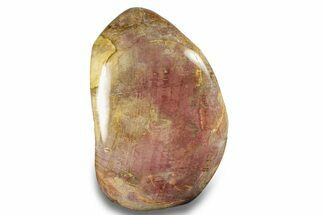This Specimen has been sold.
6.15" Free-Standing, Polished Petrified Wood - Madagascar
This is a 6.15" tall, polished section of colorful petrified wood from Ambilobe, Madagascar. The base of the piece has been cut flat so that it stands up nicely on a hard surface.
This specimen is from the early Triassic period, approximately 220 million years old, close to the time the first dinosaurs appeared on the planet. It is from a genus of conifer called Araucaria: they used to dominate forests during the Jurassic and Cretaceous periods, but now are limited to a handful of species across the southern hemisphere. The most recognized species of Araucaria today are the monkey puzzle, or pewen, trees, native to Chile and Argentina.
This specimen is from the early Triassic period, approximately 220 million years old, close to the time the first dinosaurs appeared on the planet. It is from a genus of conifer called Araucaria: they used to dominate forests during the Jurassic and Cretaceous periods, but now are limited to a handful of species across the southern hemisphere. The most recognized species of Araucaria today are the monkey puzzle, or pewen, trees, native to Chile and Argentina.
What Is Petrified Wood
Petrified wood is the name given to wood that has been turned into stone (fossilized) through the process of permineralization. In this process, all of the organic matter becomes replaced by minerals, while much of the original structure, such as tree rings, is retained. For this to happen, the wood needs to be buried in an environment low in oxygen to prevent decomposition and with flowing, mineral-laden water, so minerals may replace structures. The coloration is caused by various minerals that present in that water during fossilization. For example, red colors are due to iron compounds, greens due to copper, and so on.
Petrified wood is the name given to wood that has been turned into stone (fossilized) through the process of permineralization. In this process, all of the organic matter becomes replaced by minerals, while much of the original structure, such as tree rings, is retained. For this to happen, the wood needs to be buried in an environment low in oxygen to prevent decomposition and with flowing, mineral-laden water, so minerals may replace structures. The coloration is caused by various minerals that present in that water during fossilization. For example, red colors are due to iron compounds, greens due to copper, and so on.
SPECIES
Araucaria (Conifer)
LOCATION
Ambilobe, Madagascar
FORMATION
Isalo II Formation
SIZE
6.15 x 3 x 2.85"
CATEGORY
SUB CATEGORY
ITEM
#271816
We guarantee the authenticity of all of our specimens.
 Reviews
Reviews











